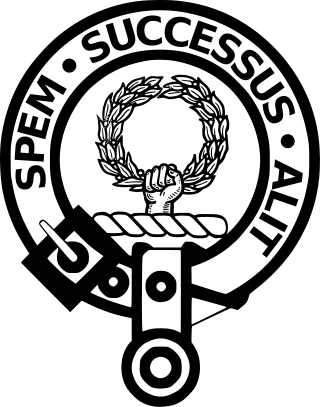
Clan Ross is a Highland Scottish clan. The original chiefs of the clan were the original Earls of Ross.
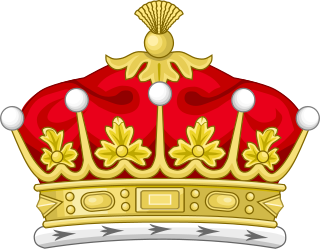
Earl of Strathmore and Kinghorne is a title in the Peerage of Scotland and the Peerage of the United Kingdom. It was first created as Earl of Kinghorne in the Peerage of Scotland in 1606 for Patrick Lyon. In 1677, the designation of the earldom changed to "Strathmore and Kinghorne". A second earldom was bestowed on the 14th Earl in the Peerage of the United Kingdom in 1937, leading to him being titled as the 14th and 1st Earl of Strathmore and Kinghorne.

Ruthven Barracks, near Ruthven in Badenoch, Scotland, are the best preserved of the four barracks built in 1719 after the 1715 Jacobite rising. Set on an old castle mound, the complex comprises two large three-storey blocks occupying two sides of the enclosure, each with two rooms per floor. The barracks and enclosing walls were built with loopholes for musket firing, and bastion towers were built at opposite corners. Destroyed by Jacobites following their retreat after the Battle of Culloden in 1746, the Barracks ruins are maintained as a scheduled monument by Historic Environment Scotland. They are accessible at all times without entrance charge.
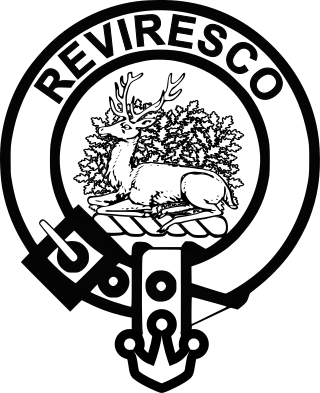
Clan Maxwell is a Scottish clan of the Scottish Lowlands and is recognized as such by the Lord Lyon King of Arms. However, as the clan does not currently have a chief, it is considered an armigerous clan.

Clan MacDougall is a Highland Scottish clan, historically based in and around Argyll. The Lord Lyon King of Arms, the Scottish official with responsibility for regulating heraldry in Scotland, issuing new grants of coats of arms, and serving as the judge of the Court of the Lord Lyon, recognizes under Scottish law the Chief of Clan MacDougall. The MacDougall chiefs share a common ancestry with the chiefs of Clan Donald in descent from Somerled of the 12th century. In the 13th century the Clan MacDougall whose chiefs were the original Lords of Argyll and later Lords of Lorne was the most powerful clan in the Western Highlands. During the Wars of Scottish Independence the MacDougalls sided with the Clan Comyn whose chiefs rivaled Robert the Bruce for the Scottish Crown and this resulted in clan battles between the MacDougalls and Bruce. This marked the MacDougall's fall from power and led to the rise of their relatives, the Clan Donald, who had supported Bruce and also the rise to power of the Clan Campbell who were then the habitual enemies of the MacDougalls and later of Clan Donald.

Clan Gunn is a Highland Scottish clan associated with lands in northeastern Scotland, including Caithness, Sutherland and, arguably, the Orkney Isles. Clan Gunn is one of the oldest Scottish Clans, being descended from the Norse Jarls of Orkney and the Pictish Mormaers of Caithness.
A laird is the owner of a large, long-established Scottish estate. In the traditional Scottish order of precedence, a laird ranked below a baron and above a gentleman. This rank was held only by those lairds holding official recognition in a territorial designation by the Lord Lyon King of Arms. They are usually styled [name] [surname] of [lairdship]. However, since "laird" is a courtesy title, it has no formal status in law.

Clan Borthwick is a Scottish clan.

Clan Fraser of Lovat is a Highland Scottish clan and the principal branch of Clan Fraser. The Frasers of Lovat are strongly associated with Inverness and the surrounding area since the Clan's founder gained lands there in the 13th century.

Clan Crichton is a Lowland Scottish clan that historically ruled Dumfries.

Clan Cunningham is a Scottish clan. The traditional origins of the clan are placed in the 12th century. However, the first contemporary record of the clan chiefs is in the thirteenth century. The chiefs of the Clan Cunningham supported Robert the Bruce during the Wars of Scottish Independence. In the 15th and 16th centuries, the Clan Cunningham feuded with the Clan Montgomery. Historically, the chief of Clan Cunningham held the title of Earl of Glencairn. However, in modern times the chief of the clan is Cunningham of Corsehill. On 18 December 2013, Sir John Christopher Foggo Montgomery Cunninghame, Baronet of Corsehill, was recognized by Lord Lyon as Clan Chief after the chiefship had been vacant for over 200 years.

The Forresters are an ancient and noble clan of the Scottish Lowlands.

Clan Stewart (Gaelic: Stiùbhart) is a Scottish Highland and Lowland clan. The clan is recognised by Court of the Lord Lyon; however, it does not have a Clan Chief recognised by the Lord Lyon King of Arms. Because the clan has no chief it can be considered an armigerous clan; however, the Earls of Galloway are now considered to be the principal branch of this clan, and the crest and motto of The Earls of Galloway's arms are used in the Clan Stewart crest badge. The Court of the Lord Lyon recognises two other Stewart/Stuart clans, Clan Stuart of Bute and Clan Stewart of Appin. Clan Stuart of Bute is the only one of the three clans at present which has a recognised chief.
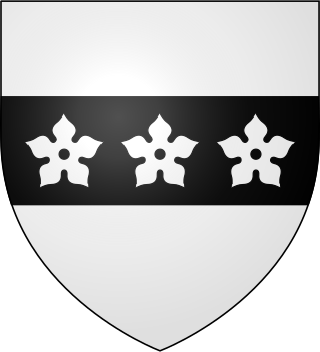
Clan Boswell is a Lowland Scottish clan and is recognized as such by the Lord Lyon King of Arms. However the clan does not currently have a chief and is therefore considered an Armigerous clan.

Finlaggan is a historic site on Eilean Mòr in Loch Finlaggan. The Loch, the island, and Finlaggan Castle lie on Islay, around two kilometres to the northwest of Ballygrant.

The Corbet family is an English family of Anglo-Norman extraction that became one of the most powerful and richest of the landed gentry in Shropshire. They trace their ancestry to two barons found in the 1086 Domesday Book and probably derive from the Brioton and Essay region, near Sées in Normandy. The name Corbet derives from the Anglo-Norman word corb, meaning "crow", matching the modern French corbeau. Variants of the name include: Corbet, Corbett, Corbitt, Corbit, Corbetts, Corbete, Corben and possibly the variant of Corbin. It has cognates in other languages: the Spanish name Cuervo, for example, which generally means a raven or rook. The underlying derivation is from the Latin word corvus, crow. Generally it is thought to be a jocular reference to a person who was thought to resemble a crow: in hair colour, tone of voice or shape of nose. However, the Scandinavians believed that a raven on the battlefield was a beneficial omen and ensured victory.

Moubray House, 51 and 53 High Street, is one of the oldest buildings on the Royal Mile, and one of the oldest occupied residential buildings in Edinburgh, Scotland. The façade dates from the early 17th century, built on foundations laid c. 1477.
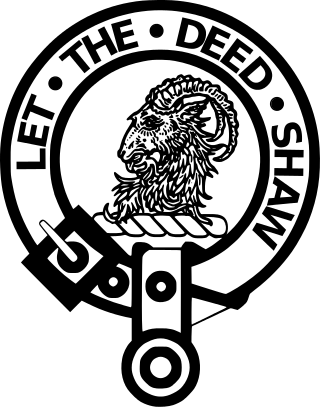
Clan Fleming is a Lowland Scottish clan and is officially recognized as such by the Lord Lyon King of Arms. However, as the clan does not currently have a chief that is recognized by the Lord Lyon King of Arms it is therefore considered an armigerous clan.
Clan McKerrell, also known as Clan MacKerrell, is Scottish clan. The clan is officially recognized by the Court of the Lord Lyon, however as it does not currently have a chief recognized by the Lord Lyon King of Arms it is considered an Armigerous clan.
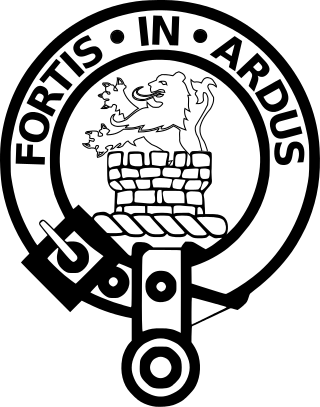
Clan Middleton is a Lowland Scottish clan. It is recognised as such by the Court of the Lord Lyon, And it does currently have a chief recognized by the Lord Lyon King of Arms.
















